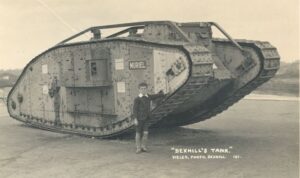The years prior to the First World War saw experiments with tracked armoured vehicles in several countries. In Britain the Landships Committee looked at the possibility of such vehicles as troop transporters, but development went in favour of such vehicles being mobile gun platforms.
William Foster & Company Limited of Lincoln, manufactures of agricultural machinery, began manufacture. To maintain security the name ‘tank’ was adopted as workers at the factory were told that they were producing mobile water tanks for use in the Middle East.
Tanks were ‘male’ or ‘female’, depending upon whether their armament comprised two 6-pounder cannon with three machine guns or just machine guns. The crew comprised of eight, four of whom were needed to handle the steering and drive gears. The tanks were not fast, only being able to move at about 4 miles per hour which matched the pace of marching soldiers. This was a great advantage on the battlefield.
A tank’s armour could stop small arms fire and fragments from high-explosive artillery shells. But they were vulnerable to a direct hit. The interior environment was extremely unpleasant. Ventilation was inadequate and the atmosphere was heavy with cordite fumes from firing the weapons and carbon monoxide fumes from the engine. Temperatures inside could reach 50 degrees centigrade.
The first use of tanks on the battlefield was the use of 49 Mark I tanks at the Battle of Flers-Courcelette on 15 September 1916. The results were mixed as many broke down, but nearly a third succeeded in breaking through.
Muriel the Tank
The most famous use of tanks in the First World War was the Battle of Cambrai in November 1917 which provides a link to Bexhill. Bexhill had always been good at fundraising for the war effort. In April 1918 the town raised over £58,000 for the War Bond Campaign. Further fundraising for Gun Week in July 1918 raised over £47,000. In recognition of such efforts, Bexhill was offered a tank by the National War Savings Committee.

Bexhill’s tank was a Mark IV, serial 2383 made in Lincoln by Fosters. It had seen action at the Battle of Cambrai as C27 Centaur II. Originally manufactured as a Male, it was armed with cannon. After operational service it was converted to a Female, armed with machine guns. Tank 2383 arrived without ceremony in September 1919 and was held at railway sidings until the formal presentation ceremony a week later.
The tank was named Muriel after the Countess De La Warr. Following the Ceremony at Town Hall Square, Muriel trundled the streets with an alarming habit of suddenly stopping and starting. She processed, accompanied by a large crowd, to “the land west of the park”. At the Polegrove she gave a demonstration of rough ground performance before driving to her resting place on West Parade. Here she later attracted the attention of local youth. In vandalism proceedings, the town clerk spoke of absolutely uncontrolled hooliganism. The tank was sited at the extreme end of West Parade by the flagpole. It is not known when she was taken away, or where she eventually ended up.

